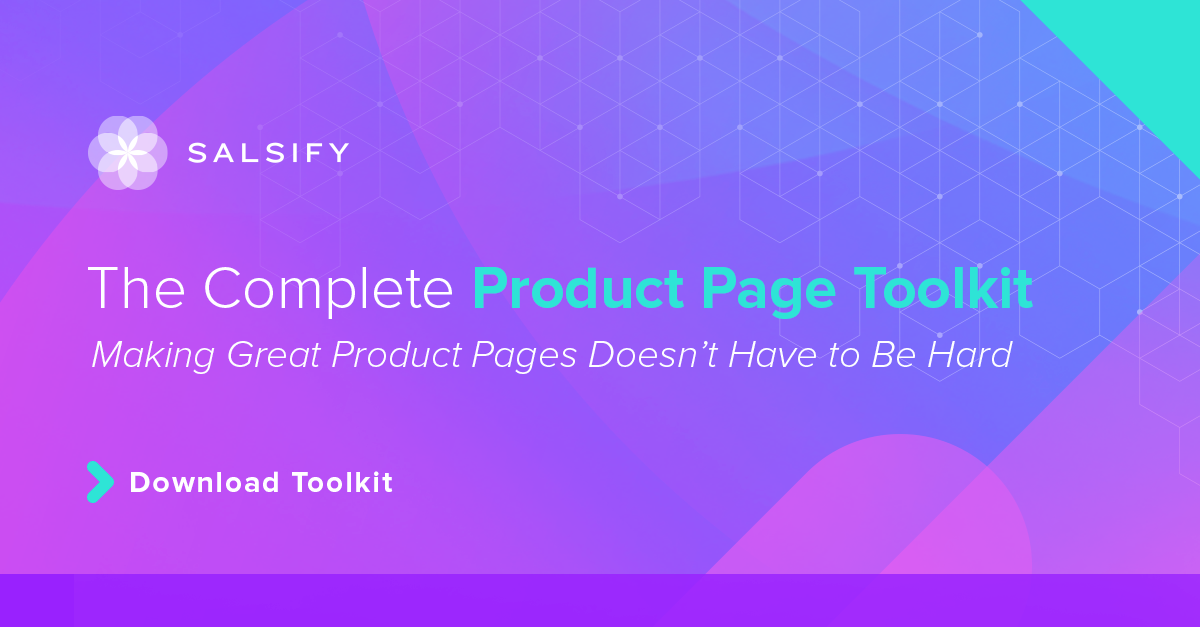

The Complete Product Page Toolkit
Download this product page toolkit to get everything you need to create engaging, high-performing product pages that drive sales and build trust with shoppers.
DOWNLOAD TOOLKITPIM
Manage all product content in one central system of record.
Activation
Easily syndicate product content to every consumer touch point.
Enhanced Content
Enrich product pages with below-the-fold content and rich media.
Catalog Sites
Share customized, up-to-date digital product catalogs.
Automation
Enhance collaboration with Salsify’s automated workflow engine.
Activation Insights
Continuously optimize your organization’s product content syndication.
GDSN Data Pool
Synchronize standard supply chain, marketing, and ecommerce attributes globally.
PXM Platform, Integrations, and APIs
Integrate the PXM platform with the rest of your enterprise systems architecture.
Supplier Onboarding
Accelerate supplier onboarding while ensuring your schema requirements are met.
Product Listing
Sell products faster with Product Listing.
Content Enrichment
Increase online conversions with Content Enrichment.
Automation
Save time and increase operational efficiency with retail automation.
SXM Platform, Integrations, and APIs
Integrate the SXM platform with the rest of your enterprise systems architecture.
Activation Network
Automate how you exchange product content data to the digital shelf.
Enhanced Content Network
Turn product pages into product experiences with Enhanced Content.
Ecommerce Platform Integrations
Create winning product experiences on owned sites with powerful ecommerce software.
GDSN Data Pool
Synchronize standard supply chain, marketing, and ecommerce attributes globally.
Open Catalog
Connect to the digital shelf faster with an open, standardized, and free product catalog.
Resources
Resource Library
Explore our ecommerce resources to get everything you need to win on the digital shelf.
Blog
Read our blog to get actionable insights for navigating changing markets and industry demands.
Webinars
Watch our on-demand ecommerce webinars to gain expert advice and tips from our community of industry leaders.
Engineering Blog
Explore our engineering blog to get developer resources, insights, and tips.
Events
Register for our upcoming in-person and virtual events to connect with other industry insiders.
Knowledge Base
Investigate our knowledge base to build your Salsify skills and understanding.
Product Updates
Explore the latest news and updates for Salsify products.
API
Examine our comprehensive API and webhook guides to start working with Salsify quickly.

Download Salsify's report to get insights into the latest trends and consumer behaviors.

As far back as ancient Rome, buyers have been advised to beware of defective and counterfeit goods.
But the idea of caveat emptor hasn’t exactly helped sellers combat the copying of their own manufactured goods. Indeed, your brand can feel helpless in the Wild West of ecommerce, where consumers can buy merchandise from millions of digital channels and marketplaces and not always have insight into the provenance of a product.
The trade of illegitimate goods not only hurts business profits, but some knock-off goods pose a safety threat because of their poor design. Unfortunately, it’s sometimes hard to tell what’s real and what’s fake on a crowded and busy online square.
More online purchases mean more opportunities for the sale of counterfeit goods. And it means your brand has even greater reason to make consumers aware of the benefits of your products.
Just as ecommerce sales rise, so does the trade in counterfeit products. In a study of product piracy, the Organization for Economic Cooperation and Development (OECD) and the European Union’s Intellectual Property Office found that trade in counterfeit and pirated goods represented more than 3% of global trade.
That might seem like a low figure, but consider that OECD’s most recent estimated value of imported fake goods across the world was $509 billion.
This blatant infringement of copyrights and trademarks reduces brands’ profits and the tax revenue of governments. Estimates for lost profits vary widely by industry, but a recent U.S. Customs and Border Patrol bust of a small fishing vessel in California illustrates how much money brands can lose with just one illegal operation.
Thirty-two million dollars worth of phony Air Jordan sneakers, Viagra pills, headphones, and other bogus merchandise were on board, according to the online magazine Input. In 2020, the agency seized 26,503 shipments containing counterfeit goods that had an estimated value of nearly $1.3 billion.
As the OECD and EU observe in their study, customer trust and loyalty also diminish when consumers believe they’re buying a trusted brand but later realize they’ve been tricked into purchasing fake food, electronics, medical supplies, cosmetics, and car parts — and especially when those bogus products don’t meet government safety standards and pose health and safety risks.
The Office of the United States Trade Representative recently found 39 online markets and 34 physical markets engaging in or facilitating “substantial trademark counterfeiting and copyright piracy.” It’s no wonder brands might believe they can’t possibly keep up with it all.
A major U.S. company told the Senate Finance Committee that 72% of merchandise it spotted on online marketplaces such as Amazon, Alibaba, and eBay was marketed as genuine but was, in fact, counterfeit. The company says it annually removes about 600,000 infringing listings from more than 100 global online marketplaces but still can’t stop the sale of goods that mimic its own products.
Amazon, for one, says it’s stepping up efforts to end fraudulent sales. The retailer says it recently seized and destroyed more than 2 million counterfeit products that third-party sellers had sent to Amazon warehouses in 2020 and that it blocked more than 10 billion suspected bad listings on its website, Ars Technica reports.
Your brand can’t rely on the anti-piracy efforts of others, nor can you play whack-a-mole and chase down every single online sale of copied goods. But you can take three steps that will shape the online perception of your brand’s legitimacy and show consumers they’re buying only what’s true.
Of course, that fine-grained level of messaging isn’t always easy to maintain on a large scale when your products are spread across scores of online retailers, social commerce channels, and your own direct-to-consumer (D2C) website.
It takes dedication and can consume many manual work hours probably requiring the back-and-forth of data entry on spreadsheets.
But when your brand relies on a solution that automates content distribution, suddenly the chasm between your efforts and the wide marketplace shrinks.
Indeed, a content distribution system that coalesces all information and identifies data inconsistencies across your product line enables you to uniformly curate content and push out a consistent message, product by product, to all of your retail partners.
Original, authentic content puts your stamp on a product and lets consumers know the truth about what they’ve bought, bringing them closer to your brand alone.
Many consumers have taken an interest in how and where products are made. They closely study the sourcing of products and often base their loyalty on whether a brand’s supply chain safeguards worker safety, pays fair wages, and abides by non-destructive environmental standards.
While many consumers unsuspectedly buy knock-off goods, many others intentionally buy cheaper copycat merchandise to save money — however, they’re unaware or don’t care about the poor labor and environmental practices behind the sourcing of those products.
Brands can define sourcing on their terms when they have control of the content of all their legitimate products.
As Harvard Business Review notes in an article about the counterfeiting problems luxury goods companies face: "Logos are easy to knock off, but good craftsmanship isn’t. To make fakes less attractive to consumers, luxury firms will need to emphasize a style and quality that is tough to replicate and is independent of the logo. Emphasizing traditional craftsmanship, handmade components, and heritage techniques is a powerful way of infusing a brand with authenticity.”
That’s the type of messaging all brands can convey when they control the narrative.
The more insight you have about products on your digital shelf — basically, all of the digital touchpoints through which consumers interact with your brand — you’ll have a comprehensive understanding of how shoppers view your products and whether you’re losing the messaging game with the online descriptions of counterfeit products.
For one, digital shelf analytics gathers customer feedback so you can optimize product content to not only boost sales but also directly address the legitimacy and benefits of your product and dispel sentiment of counterfeit goods.
The solution should also recommend SEO keywords that will push your merchandise to the top of searches.
While the vast, murky underworld of counterfeit products seems hard to beat, with automated content distribution, the right words about product sourcing, and effective digital shelf analytics, your brand can let consumers know the real you and win the battle against the phonies.

Download this product page toolkit to get everything you need to create engaging, high-performing product pages that drive sales and build trust with shoppers.
DOWNLOAD TOOLKITStanding out on the digital shelf starts with access to the latest industry content. Subscribe to Below the Fold, our monthly content newsletter, and join other commerce leaders.